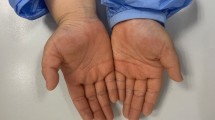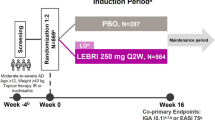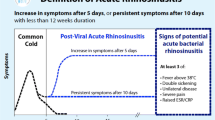Abstract
Introduction: Rhinitis is defined as inflammation of nasal mucosa. Allergic rhinitis is the most common type of chronic rhinitis with increasing prevalence. Tests such as nasal smear for eosinophilia, Skin prick test, Serum absolute eosinophil count and Immunoglobulin IgE helps us in diagnosis of allergic rhinitis. Objective: To evaluate the efficacy of the nasal smear for eosinophilia and blood absolute eosinophil count tests to diagnose allergic rhinitis in patients with varied severity of symptoms. Materials and methods: In this prospective study, all patients above 12 years of age with symptoms suggestive of allergic rhinitis were enrolled in our study. Severity assessment was done by visual analog scoring and Total nasal outcome scoring. Diagnostic nasal endoscopy with nasal smear for eosinophilia, complete blood count and blood absolute eosinophil count tests were done. Results: A total of 60 patients were enrolled in the present study. Age ranged from 13 to 55 years with female preponderance. The most common symptom was rhinorrhea found in 100% of study population, followed by sneezing present in 57 (93.5%) patients. 10 out of 12 patients with mild intermittent symptoms had < 5% of eosinophil elicited in nasal smear and 2 patients had negative smear of eosinophils. Only 13% had mild eosinophilia. In this study, in those patients with mild intermittent symptoms neither nasal smear eosinophilia nor Blood absolute eosinophil count was found to be significant. Conclusions: Nasal smear cytology and blood absolute eosinophil count were found to be significant only in patients with moderate-severe symptoms. Those patients with mild intermittent symptoms need not be tested as it will be insignificant. In these patients, we must rely on the visual analogue score based on the severity of symptoms rather than laboratory tests.

Similar content being viewed by others
References
Bousquet J, Schünemann HJ, Togias A, Bachert C, Erhola M, Allergic Rhinitis and Its Impact on Asthma Working Group (2020) Jan;145(1):70–80.e3 ;. Next-generation Allergic Rhinitis and Its Impact on Asthma (ARIA) guidelines for allergic rhinitis based on Grading of Recommendations Assessment, Development and Evaluation (GRADE) and real-world evidence. J Allergy Clin Immunol. doi: https://doi.org/10.1016/j.jaci.2019.06.049. Epub 2019 Oct 15. Erratum in: J Allergy Clin Immunol. 2022 Jun;149(6):2180. PMID: 31627910
Small P, Keith PK, Kim H (2018) Allergic rhinitis. Allergy Asthma Clin Immunol. Sep 12;14(Suppl 2):51. doi: https://doi.org/10.1186/s13223-018-0280-7. PMID: 30263033; PMCID: PMC6156899
Ellis AK, Soliman M, Steacy L (2015) The allergic rhinitis - clinical Investigator Collaborative (AR- CIC): nasal allergen challenge protocol optimization for studying AR pathophysiology and evaluating novel therapies. Allergy Asthma Clin Immunol 11(1):16
Patel AK, Nagpal TP (2014) Comparison of blood absolute eosinophil count and nasal smear eosinophils with symptoms and severity of clinical score in patients of allergic rhinitis. Indian J Allergy Asthma Immunol 28:74–77
BritoBabapulle F (2003) The eosinophilias, including the idiopathic hypereosinophilic syndrome. Br J Haematol 121:203–223
Robbins & (2010) Cotran pathologic basis of Disease, 8th edn. Elsevier, Philadelphia, pp 504–505
Galli SJ, Tsai M, Piliponsky AM (2008) The development of allergic inflammation. Nature 454(7203):445
Romagnani S (2002) Cytokines and chemoattractants in allergic inflammation. Mol Immunol 38(12–13):881–885
Chanda R, Aggarwal AK, Kohli GS, Jaswal TS, Gupta KB (2002) Comparative study of nasal smear and biopsy in patients of allergic rhinitis. Ind J Allergy Asthma Immunol 16(1):27–31
Mygrind N, Weeks B, Dirksin A, Johnson NJ (1978) Perenial rhinitis: an analysis of skin testing, serum IgE and blood and smear eosinophilla in 201 patients. Clin Otolaryngol 3:189–196
Berkiten G, Aydoğdu İ, Kumral TL, Saltürk Z, Uyar Y, Arslanoğlu A, Tutar B, Göker AE (2018) Nasal eosinophilia in nasal smears of patients with persistent and intermittent allergic rhinitis. J Laryngol Otol 1–4. https://doi.org/10.1017/S0022215118001986
Miller RE, Paradise JL, Friday GA et al (1982) The nasal smear for eosinophils. Am J Dis Child 136:1009–1011
Akeem O, Lasisi MBChB, Hakeem FWACSFMCORL, Lawal O, Ogun MBBSGO, Path MBBSFMC, Oluwasola A FWAC P, M. O. Odubanjo, MBBS, FMCPath, Alli Salisu, MBBS, and Shuaib K. Aremu, MBBS.
Chen ST, Sun HL, Lu KH et al (2006) Correlation of immunoglobulin E, eosinophil cationic protein, and eosinophil count with the severity of childhood perennial allergic rhinitis. J Microbiol Immunol Infect 39(3):212–218
Lans DM, Alfano N, Rocklin R (1989) Nasal eosinophilia in allergic and non-allergic rhinitis: usefulness of the nasal smear in the diagnosis of allergic rhinitis. Allergy Proc 10:275–280
Sood A (2005) Diagnostic significance of nasal eosinophilia in allergic rhinitis. Ind J Otorhinolaryngol Head Neck Surg 57:13–16
Liu F, Zhang J, Liu Y, Zhang N, Holtappels G, Lin P et al (2010) Inflammatory profiles in nasal mucosa of patients with persistent vs intermittent allergic rhinitis. Allergy 65:1149–1157
OlusesiAD, SaidMA AmoduEJ (2007) Acorrelation of symptomatology with nasal smear eosinophilia in noninfectious chronic rhinitis preliminary report. Niger J Clin Pract 10:238–242
Author information
Authors and Affiliations
Corresponding author
Ethics declarations
Conflict of Interest
Author declares no conflict of interest.
Additional information
Publisher’s Note
Springer Nature remains neutral with regard to jurisdictional claims in published maps and institutional affiliations.
Electronic Supplementary Material
Below is the link to the electronic supplementary material.

Rights and permissions
Springer Nature or its licensor (e.g. a society or other partner) holds exclusive rights to this article under a publishing agreement with the author(s) or other rightsholder(s); author self-archiving of the accepted manuscript version of this article is solely governed by the terms of such publishing agreement and applicable law.
About this article
Cite this article
M., S., Gopal, S., P.M., R. et al. A Study on the Significance of Nasal Smear Eosinophil Count and Blood Absolute Eosinophil Count in Patients with Allergic Rhinitis of Varied Severity of Symptoms. Indian J Otolaryngol Head Neck Surg 75, 3449–3452 (2023). https://doi.org/10.1007/s12070-023-03945-5
Received:
Accepted:
Published:
Issue Date:
DOI: https://doi.org/10.1007/s12070-023-03945-5




